MTSS syndrome
Medial tibial syndrome (MTSS) is an injury that causes pain on the inside of the lower leg (front of the leg between the knee and the ankle) aka: the tibia (bone in the lower leg). MTSS syndrome occurs in runners and athletes with a lot of jump-related strain, among others. MTSS complaints are approached in modern physiotherapy the same way as tendon injuries (example: Achilles tendon injury). With these injuries, pain-relieving techniques are chosen combined with gradual build-up of load. With prolonged overuse/too little recovery, MTSS-related symptoms can develop.

Possible causes
- Enlarged tilt of the foot (overpronation), requiring surrounding muscles to work harder (muscles that are active include: musculus tibialis posterior, musculus soleus and the musculus flexor digitorum longus are active when running). An imbalance where the body has to constantly adapt can lead to 'overuse' symptoms.
- Unilateral use of the road (due to drainage from the road surface). Depending on the type of surface you walk on, this can cause one foot to be loaded more than the other. This uneven distribution of load sometimes contributes to the onset or perpetuation of complaints.
- Sports involving repeated jumping and or running (Repeated pressure on the lower leg can lead to excessive compression).
- In women, MTSS symptoms are more common than in men.
- Beginning runner, possibly due to inefficient running technique or sudden increase in load.
- Overweight
- Reduced strength in the hip muscles allowing it to provide insufficient stability while running.
Complaints and symptoms
- Pain at the level of the lower ⅔ part of the tibia (tibia)
- Radiation to the knee and or ankle
- Hypersensitivity of the shins when touched (palpation) leading to a sharp painful sensation
- Dull pain after load that lasts longer

Treatments and prognosis
A number of factors are important during the rehabilitation of MTSS. The first is training muscles around the hip and buttock region. A weaker hip gives less stability and is less able to handle the impacting forces of running. The body always finds a compensation strategy for an inadequate movement pattern like the one we describe above. This compensation may then cause symptoms in other areas such as the muscles in the shin.
Acting on time
The earlier these complaints are spotted, the less chance the injury has to develop. With these complaints, slowly building up the load (rehabilitation) is crucial.
Continue to excite
Tendon repair in MTSS involves rest, but not complete rest. Continued 'stimulation' of tendon tissue is essential for the tendon to recover properly. Gradual and dosed loading is really the key to success. Symptoms may be felt during exercises but in moderation. So consult well with your physiotherapist what is possible within the pain limit. So in many cases this means taking a step back in intensity, but only rarely do we opt for a temporary complete stop. With a personalised exercise schedule, you build step by step towards a full recovery and a good load-bearing capacity of the tibia, allowing you to play pain-free sports again.
Stretching for MTSS complaints
Stretching the shin muscles can provide relief. In some cases, another option is a massage where the affected tissue (the shin) is gently massaged. This has a pain-relieving effect.
Strength building
Training for MTSS symptoms is twofold. For instance, training muscles around the hip and buttock region is important, as a weaker hip gives less stability and cannot handle the impacting forces of running as well. Besides global strength training, it is also important to make the muscles at the tibia itself as load-bearing as possible.
Gait analysis
We also look at the quality of movement through a gait analysis. From here, we can give targeted advice on running technique and thus reduce the risk of injury.
Sports-specific
Finally, we look at the specific skills needed within your sport. Depending on the type of sport, your treating physiotherapist will create training forms that mimic the sport-specific situations as closely as possible so you won't face any more surprises.
At Fysio Fitaal in Tilburg, we will help you get back on the track, field or hall as soon as possible! Together, we will train systematically to get your body used to the specific load. This will get you back on track as soon as possible. Do you recognise yourself in these complaints and are you looking for a (sports) physio? Then send an e-mail to info@fysiofitaal.nl. Or call 013-3020191.
Stages of pain MTSS
- stage 1; particularly pain and stiffness after exercise
- stage 2; pain during warm-up, this disappears after a good warm-up
- stage 3; pain during sports
- stage 4; daily pain symptoms and pain symptoms persisting for more than 24 hours after exercise
Making an appointment at FysioFitaal
We work from multiple locations in Tilburg, always close by for professional and accessible physiotherapy. Fill in the contact form and we will contact you soon. Together, we will work on your recovery!

